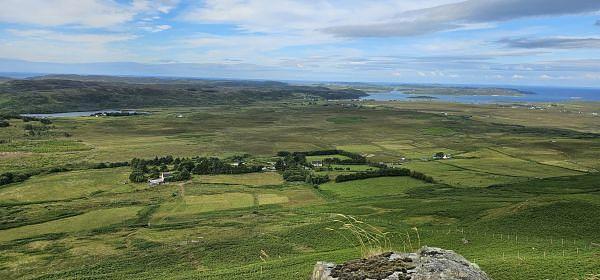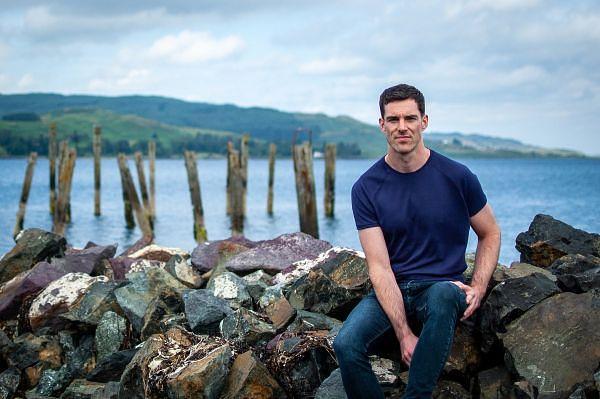
The songs of the postman, Teonaidh Chailein
Dr Alasdair C. Whyte discusses songs in the recordings on the Tobar an Dualchais website and immersion in Gaelic song culture with reference to Johnnie Campbell (Teonaidh Chailein).
My focus in this piece is on the recordings of a man still known and referred to locally in his native Iona and the Ross of Mull as Teonaidh Chailein (Tobar an Dualchais, Person ID: 5658).
Teonaidh would be Seonaidh in many other districts but Teonaidh is the form of this personal name found in this part of the Hebrides.
Our Teonaidh was usually Johnnie Campbell in an English-speaking context.
Teonaidh’s mother was Oighrig Chaimbeul (Effie Campbell) and Teonaidh was born in Culdamh in Iona on 7 March 1905. The Cailean in Teonaidh’s patronymic is his stepfather, Cailean MacAonghais (Colin MacInnes), a tailor from the Ross of Mull.
The family moved to Taoslainn in the south-west part of Mull when Teonaidh was six and it was in Taoslainn that Teonaidh spent most of his life.
He was the local postie and, as Dr Mairi MacArthur put it in a recent email to me: “His years walking the roads and crofts as a postman must have added hugely to his stock of tales, lore and songs.”

In the same email, Mairi, who recorded Teonaidh on a number of occasions for the Muile air Mheamhair (Mull Oral History Project) in the 1980s, referred to his “keen sense of place, with persons or story or custom locked fast into every corner of the landscape.”
This sense of place is at the heart of the recordings of Teonaidh available to us in Tobar an Dualchais, not least in the songs he composed himself.
Among the first that he composed, as he tells us himself (Track 109852), was ‘Tìr a’ Ghoill’, a local spin on the song ‘Far an robh mi ’n-raoir’ by ‘Am Bàrd Sgitheanach’, Niall MacLeòid (Neil MacLeod) (Tracks 46139; 108196; 109853). Tìr a’ Ghoill (Tiraghoil on modern Ordnance Survey maps) lies up the hill from Bunessan in the direction of Fionnphort in the Ross of Mull.
It was a place Teonaidh associated with ‘gillean sunndach’ (‘cheerful lads’) and ‘cailean grinn’ (‘bonnie girls’) coming together to sing Gaelic songs on summer nights:
Bidh mi ’cuimneachadh rim mhaireann
Nuair a bha sinn cruinn
Sinn nar grunnan taic an rathaid
’N achlais na coill’
Gillean sunndach ’s iad gun smalan
Leis na cailean grinn
’S iomadh oidhche ’chur mi seachad
Ann an Tìr a’ Ghoill
I will remember as long as I live
When we were gathered together
In groups walking along the side of the road
Along the edge of the trees
Cheerful lads without fault
With the bonnie girls
Many a night I spend
In Tìr a’ Ghoill
Teonaidh mentions no less than 18 local places in another of his songs, ‘Dìreadh na gualann’.
He made this song from a vantage point on the top of Beinn Lì, having ascended the ben along its shoulder, as he puts it in the title of his song (Tracks 108235; 109294; 109851).
Among the places he mentions is Àirigh Mhic Ruairidh, a place unrecorded on historical or modern Ordnance Survey maps but for Teonaidh, like Tìr a’ Ghoill, it was associated with song:
’S chì mi Àirigh Mhic Ruairidh far am bualadh an sprèidh
Gan iomain aig buachaill’ le ’chuaile nan dèidh
Na h-ìghneagan bòidheach dhan dhol leis na cuaich
Gan leigeil ’s gan tàladh ’seinn nan dàn dhaibh a-suas
I see Àirigh Mhic Ruairidh where the cattle would be penned
Driven by a cowherd with his stick at their backs
The beautiful girls going to them with the pails
Milking them and lulling them; singing the songs to them
Teonaidh lived in a songscape.
Songs were intrinsic to his surrounding landscape and to daily life. In another song, ‘Seinnidh mi luinneag do Mhuile nan craobh’ (Tracks 108195; 109864), Kinloch at the head of Loch Scridain is the place associated with song: in particular, the songs of local bard Seumas Robasdan (James Robertson):
Chì mi Loch Sgrìodain ’s e sìnte a suas
Aig bun nam beann àrda is àillidh an snuadh
Mhol Seumas san Àird e ’s bha bàrdachd na dhuan
A chumail a suas a h-àilghios
I see Loch Sgrìodain stretched out upwards
At the foot of the high bens: beautiful their appearance
Seumas of An Àird praised it and there was poetry in his words
To uphold its glory
Naturally, Teonaidh Chailein, too, wanted to praise the place in song, as the chorus of this same song tells us:
Seinnidh mi luinneag do Mhuile nan craobh
Do Mhuile nam beannan nan gleannan ’s an fhraoich
Seinnidh mi luinneag do Mhuile mo ghaoil
An t-eilean san d’ fhuair mi m’ àrach
I will sing a song to Mull of the trees
To Mull of the bens and the glens and the heather
I will sing a song to Mull of my love
The island where I was raised
It was natural because Teonaidh’s upbringing was awash with the songs of local bards. He was absolutely immersed in this song culture and actively encouraged to make songs himself.

When Morag MacLeod of the School of Scottish Studies asked him on 18 April 1974 why he had started making songs in his late teens (Track 109852), Teonaidh replied:
Och dìreach bodachan a thuirt rium “Ò b’ fheàrr leam gun dèanadh tu òrain” , is rinn mi ceathramh, is bhuaithe sineach…
Och just because one old man said to me, “I wish you would make some songs”, and I made a verse, and from there…
Teonaidh talks of his family connections to some of the best-known Gaelic bards of the previous generation or two in this same Tobar an Dualchais recording.
His grandmother was a cousin of Dùghall MacPhàil (Dugald MacPhail) and his mother a cousin of Donnchadh MacIain (Duncan Johnston), and knowledge of these connections would no doubt have inspired young Teonaidh.
But it was undoubtedly his upbringing and his own lived experience in a vibrant and rich Gaelic cultural environment, as we hear from him himself, that gave rise to his songs.
These songs, in turn, and their availability to us in Tobar an Dualchais provide us with a cultural wealth in which we have to immerse our young people if Gaelic is to thrive: not just in Mull and Iona, of course, but across the areas in which we have these songs.
In some areas, these recordings can supplement the cultural wealth that people living in local communities still have today; in others, these recordings can refill the cultural well from which we can draw and pass on to our young people and from which our young people can learn to draw from themselves.
Re-awakening local songscapes like the one in which Teonaidh Chailein grew up, and to which he added, can inspire our next generation of Gaelic-speakers, thinkers and creatives.

With thanks to Dr Mairi MacArthur, George Macrae and Fiona Kyle.
For more on Teonaidh Chailein, see Ailean Boyd, ‘A’ bhàrdachd beò ann am Muile’, Gairm 134 (An t-earrach 1986), 137-43.
For recent recordings of three of Teonaidh Chailein’s songs, featuring local musicians from Mull and schoolpupils from Bunessan Primary School and B Iona Primary School, see ‘Òrain Teonaidh Chailein’ on Bandcamp: https://orainteonaidhchailein.bandcamp.com/